Contributory members are able to log private notes and comments about each site
Sites Anne T has logged. View this log as a table or view the most recent logs from everyone
Old Prior Manor House Well (Corbridge)
Trip No.149 Entry No.1 Date Added: 12th Sep 2019
Site Type: Holy Well or Sacred Spring
Country: England (Northumberland)
Visited: Yes on 8th Sep 2019. My rating: Condition 3 Ambience 3 Access 5

Old Prior Manor House Well (Corbridge) submitted by Anne T on 12th Sep 2019. A glimpse into the well chamber. It has two pottery pipes feeding into it, and a modern drain in front which takes away any overflow. The water, after a long period of very warm and wet weather, was full of bright green weed.The well lies at the eastern side of what would have been the grounds of the old Trinity Church, which was demolished in the 18th century after falling into ruins.
(View photo, vote or add a comment)
Log Text: We have driven past this well so many times and said “we need to stop and photograph this” and today we did. I thought it was just a hollow in the wall, with a dry pipe coming through the wall, but no, it is a real well, with water, although no water flowed through the pipe and the water was stagnant and full of vibrant green weed.
Looking over the wall, it had a stone domed well house.
The well is located outside the Old Prior Manor House, at the corner of the B6529, Stagshaw Road and St Helen’s Lane, with the junction with Corchester Lane, which runs to the Corbridge Roman site, diagonally opposite to the south west.
The OS map of 1895 shows the well being sited opposite Trinity Church. The house, also known as Prior Mains, was formerly the Corbridge Rectory.
Bywell Cross
Trip No.150 Entry No.1 Date Added: 12th Sep 2019
Site Type: Ancient Cross
Country: England (Northumberland)
Visited: Yes on 10th Sep 2019. My rating: Condition 3 Ambience 4 Access 5
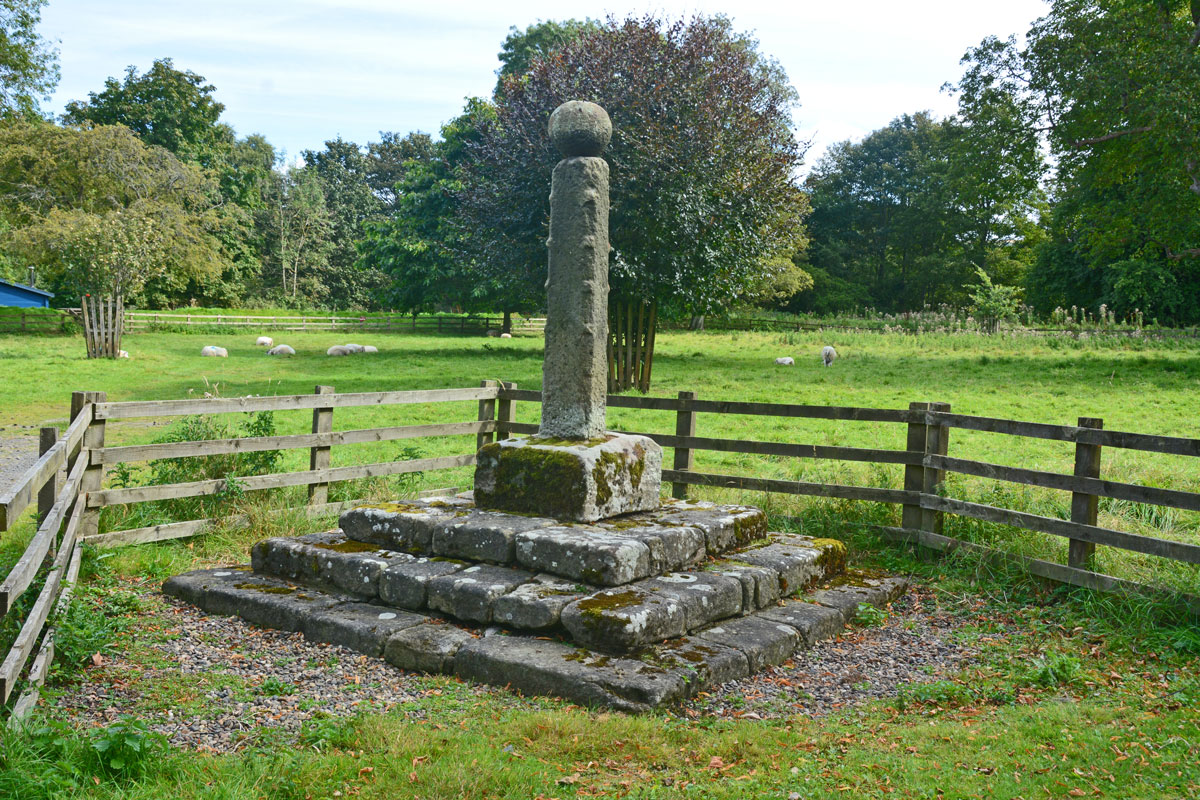
Bywell Cross submitted by Anne T on 12th Sep 2019. First view of the thirteenth century cross, moved from NZ 04876145 to its current location in 1852. It is grade II listed and stands 2.8m tall. The ball finial is dated to 1700.
(View photo, vote or add a comment)
Log Text: Bywell Cross: Considering we live less than a couple of miles from here, and we regularly pop down to walk around here, I've never really stopped to photograph the cross here. Having decided to photograph the medieval cross slabs in St Andrew's church, I got the camera out, only to find another visitor stopped to look at it.
The gentleman told me he'd been doing an annual walk around this area for the last 5(?) years, and was heading off to Ovingham/Ovington next. I decided to come back and photograph the cross after going to St Andrew's, only to find him still there!
This is a very lovely, peaceful spot, with the River Tyne about 50m away. He did eventually wander off after a brief conversation, and I popped into the field to get a photograph of the cross from its eastern side.
Old Viney Museum (Corbridge)
Trip No.151 Entry No.2 Date Added: 16th Sep 2019
Site Type: Sculptured Stone
Country: England (Northumberland)
Visited: Yes on 14th Sep 2019. My rating: Condition 3 Ambience 4 Access 4
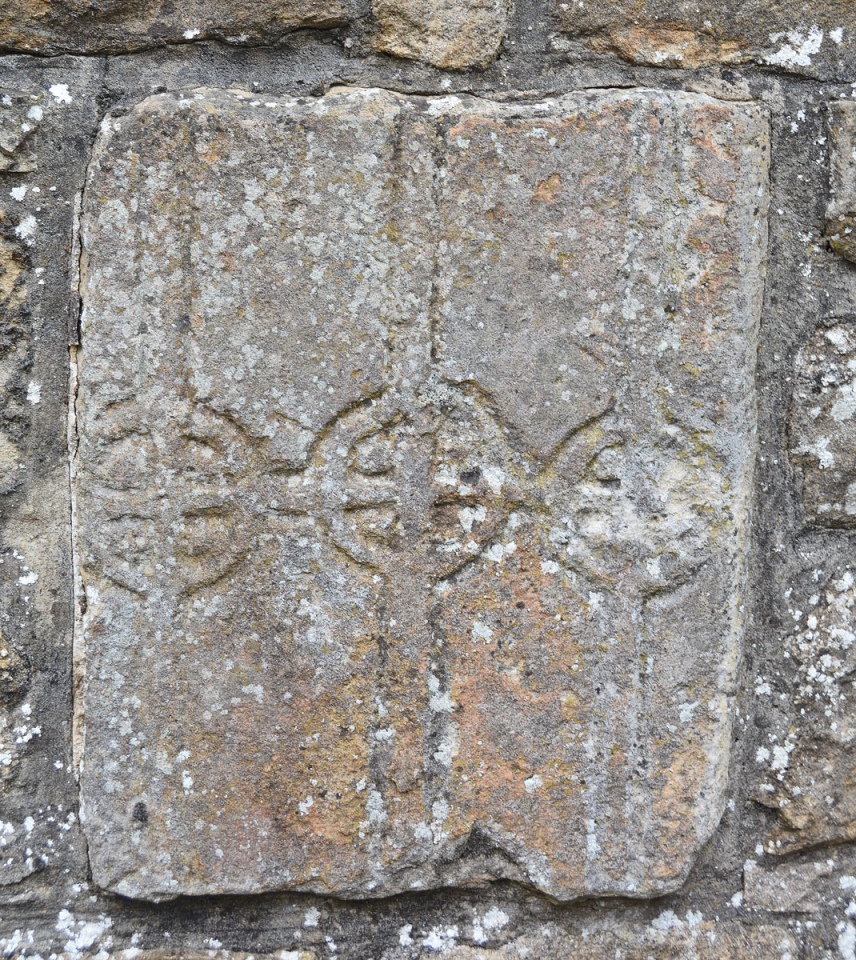
Old Viney Museum (Corbridge) submitted by Anne T on 16th Sep 2019. This stone is built into a wall at the northern side of the cottage, inside the garden. It is recorded as Ryder's Viney 3 and as the Corpus of Anglo Saxon Stone Sculpture's Corbridge 02. It is part carved with three stemmed crosses joined by horizontal arms, and is thought to have been created during the Saxon-Norman overlap period. "The centre of each cross is ringed and within the ring the arms are narrower than the uprights." The Corpus suggests it might have been the side of an altar or...
(View photo, vote or add a comment)
Log Text: The Old Viney Museum, Corbridge: [Photographed the Prince's Street Pant at the corner of the road prior to walking up Appletree Lane.] We had long sought out the location of this museum, where we knew some of the stones recorded on the Corpus of Anglo Saxon Stone Sculpture were built into its walls. Having found Peter Ryder's Cross Slab papers for south west Northumberland, we finally had a street, so went seeking the property, thinking we'd be able to see it from outside.
We were really fortunate to find the owner of the cottage working in his garage, and he was delighted to show us round, leaving us to take photographs. He was also really interested in the documentation I'd taken along (I have since sent him a copy by way of thanks). His father purchased the museum and adjacent school buildings in the 1970s and his family has owned them ever since.
What a treat! I felt so lucky to be welcomed in and to see these stones, which we've wanted to see for at least three years now. Brilliant.
St Andrew's Church (Corbridge)
Date Added: 26th Sep 2019
Site Type: Ancient Cross
Country: England (Northumberland)
Visited: Yes on 14th Sep 2019. My rating: Condition 3 Ambience 4 Access 5
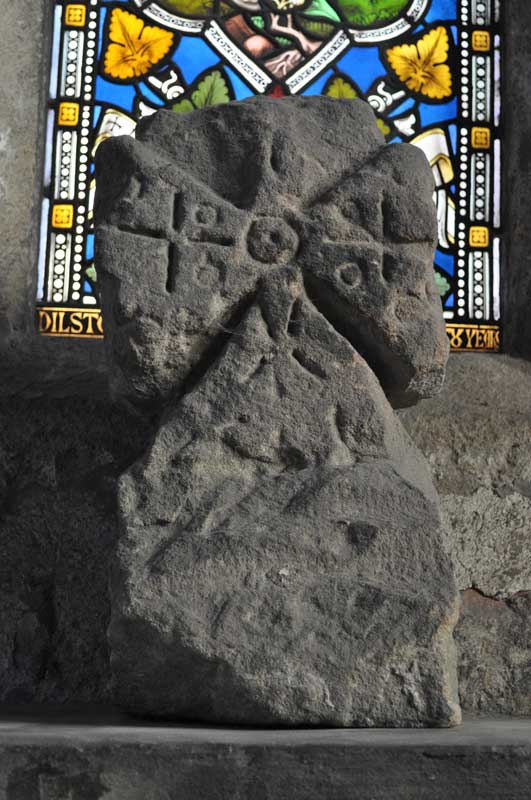
St Andrew's Church (Corbridge) submitted by Anne T on 7th Oct 2014. The eleventh century finial, though to be from the gable end of the original church. Currently located in the South Transept
(ASCorpus ref: Corbridge 05).
(View photo, vote or add a comment)
Log Text: St. Andrew's Church, Corbridge: We returned to this beautiful church, right in the heart of Corbridge, with Peter Ryder's list of medieval grave slabs. Not to be confused with St. Andrew's, Bywell, about 6 miles away.
Always a draw for visitors, this is a peaceful and thought provoking church. As we started on our list of slabs, working out way down the list from 1-21, the Canon came in with a couple of choristers and started practicing for a service, so parts of the church were 'out of bounds' to avoid disturbing them. We returned briefly on Sunday, 22nd September, mid-afternoon, to photograph the couple of slabs remaining. We were unable to find slab 21, but later realised we were looking in the wrong place, so will return to complete the list.
Rolleston Cross
Trip No.129 Entry No.1 Date Added: 21st May 2019
Site Type: Ancient Cross
Country: England (Nottinghamshire)
Visited: Yes on 10th May 2019. My rating: Condition 3 Ambience 3 Access 5
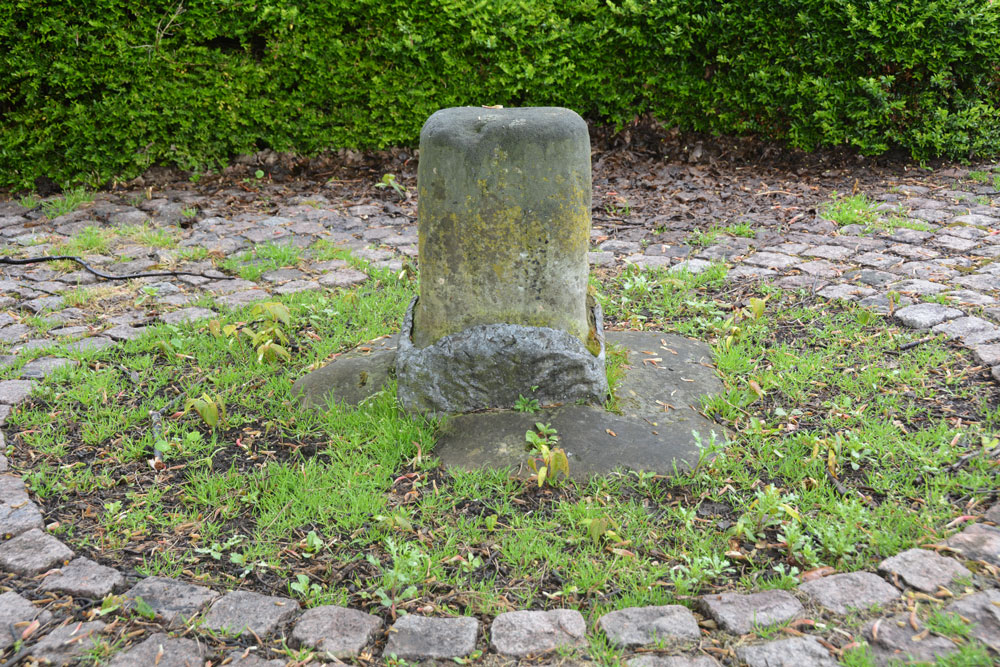
Rolleston Cross submitted by Anne T on 21st May 2019. Close up of the stump of the Rolleston Village Cross. Pastscape tells us it once had shields carved into it, although these are no longer visible, and they do not tell us who these belonged to. Dated to the 14th century, the local stocks were once said to be nearby.
(View photo, vote or add a comment)
Log Text: Rolleston Cross: This was our first stop on our way down to Dartmoor. Having stopped off in Newark for a very early breakfast, we arrived in Rolleston at 08:30, only to find (not surprisingly!) that the church had not yet been opened. After having photographed the sun dial in the churchyard of Holy Trinity, we walked up to find this old village cross, which I completely missed the first time round, as it blended in with the surrounding pavement and benches!
The very sad remains of an old village cross, but another site to have ticked off the list. By the time we'd photographed this cross stump, we walked back to Holy Trinity to find it now open.
Southwell Minster
Date Added: 29th Oct 2015
Site Type: Early Christian Sculptured Stone
Country: England (Nottinghamshire)
Visited: Yes on 20th Sep 2015. My rating: Condition 3 Ambience 4 Access 5
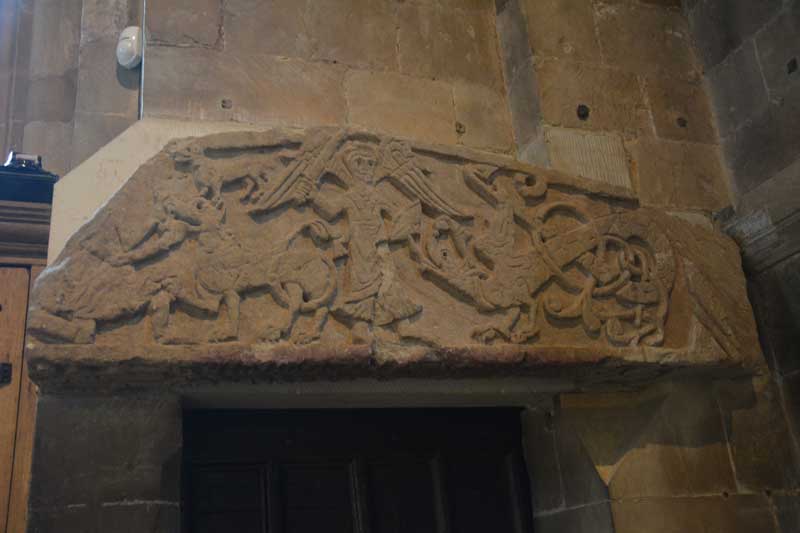
Southwell Minster submitted by Anne T on 26th Oct 2015. The front face of the tympanum, thought to come from the original Saxon building, which sits above the door on the west wall of the north transept. The carving shows St Michael warding off a dragon and is said to date from 1100.
(View photo, vote or add a comment)
Log Text: 10th/11th century tympanum, Southwell Minster, Nottinghamshire: On our way back from Grantham we took a short detour to Southwell. What a stunning little town, with a huge Minster. At the time of our visit there were two services running almost back to back, so we didn't get to see some of the early carved capitals. The tympanum on the western wall of the north transept more than made up for it, with its 11th century carving of St. Michael and the dragon facing us, then underneath (on the narrower face) was the remains of a 10th century Saxon grave cover. The light streamed through the window above, making it difficult to photograph well. I was astonished to find a photograph licence was £5! However, the greeter said as the verger was in the service, unless I was very obvious with my camera, we wouldn't be charged unless the verger spotted us! It was very late on Sunday afternoon at the time of our visit so the museum/café area wasn't open. It would be nice to go back at a time when services aren't on so we could see the quire, chancel and sanctuary and have a wander round at our leisure, but it's unlikely that we'll get back to Nottinghamshire any time soon.
Holy Trinity (Rolleston)
Trip No.129 Entry No.2 Date Added: 21st May 2019
Site Type: Ancient Cross
Country: England (Nottinghamshire)
Visited: Yes on 10th May 2019. My rating: Condition 3 Ambience 4 Access 4
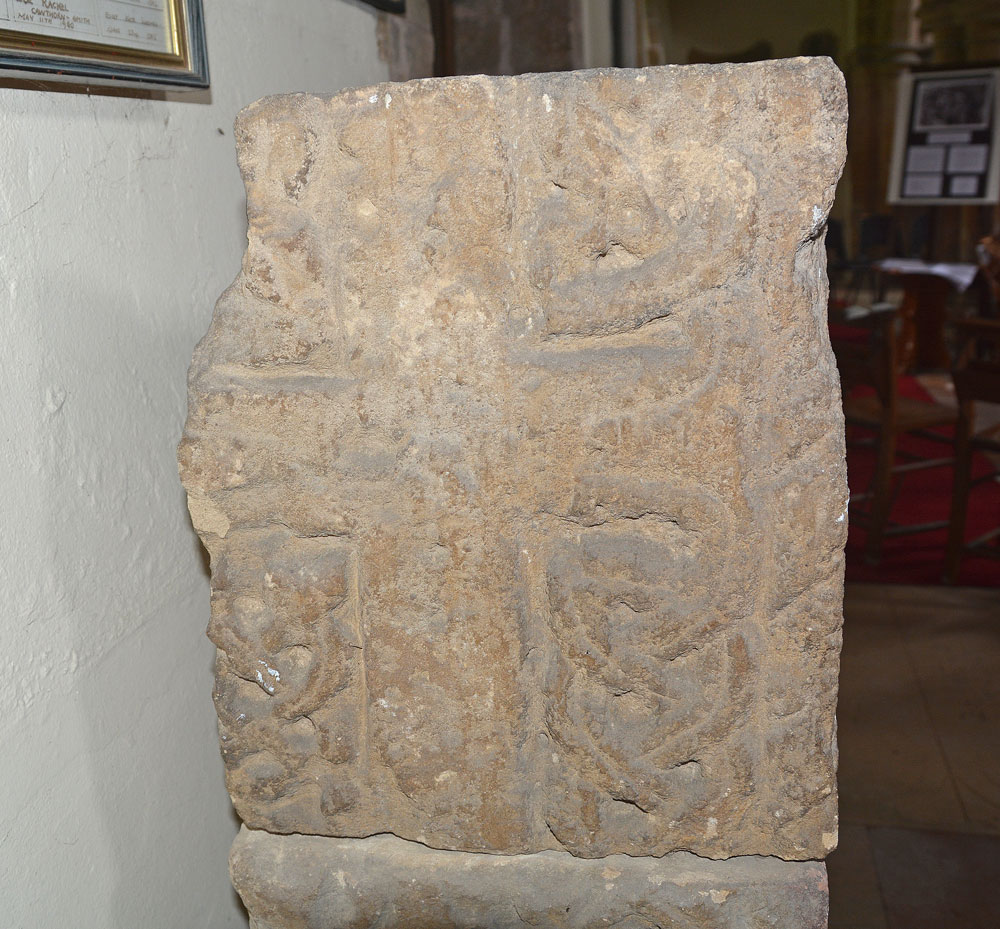
Holy Trinity (Rolleston) submitted by Anne T on 21st May 2019. The western side of the top-most block of the three making up the remains of this stone cross.
(View photo, vote or add a comment)
Log Text: Cross Shaft Fragments and Cross Slabs, Holy Trinity, Rolleston: By the time we’d photographed the sundial in the churchyard then walked up to the village cross, the church had been opened (thankfully) and we let ourselves in. The cross shaft was immediately opposite the south door into the church, although in a really difficult position to photograph (between a heavy wooden desk with information leaflets and a fire extinguisher). The most ornate section of the cross was to its western side, so after Andrew had moved the chairs, I virtually had to squeeze myself in next to the desk and squat down as best I could to capture the carvings – not the most elegant of positions!
It wasn’t until after I had photographed the cross and was making my way towards the fragments in the eastern wall of the northern aisle that I realised the chairs in the church had been set up in a labyrinth pattern. We did have to move some of the chairs to access several parts of the church, but made sure we put the chairs back exactly where we found them.
Thank goodness I had my printouts with Peter Ryder’s drawings and descriptions, as we would have missed a lot here! We’d spotted one or two of the most obvious carved stones built into the external fabric. However, now knowing how much was on the external walls, we went round the outside again and spotted so much more.
St John the Baptist (Hope Bagot)
Trip No.169 Entry No.2 Date Added: 8th Aug 2021
Site Type: Holy Well or Sacred Spring
Country: England (Shropshire)
Visited: Yes on 15th Jul 2021. My rating: Condition 3 Ambience 4 Access 4
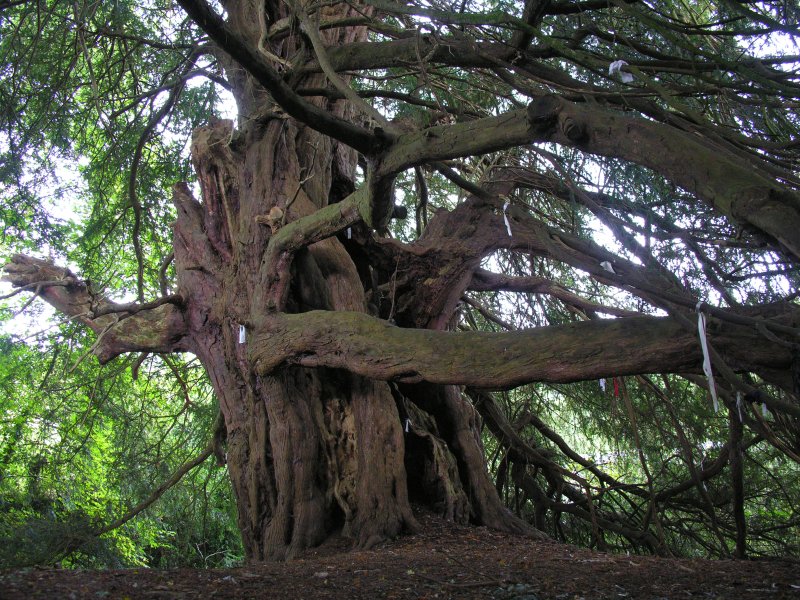
St John the Baptist (Hope Bagot) submitted by TimPrevett on 23rd Sep 2007. The yew certainly adds a heavy ambience to the place. I found it a little creepy myself, but interestingly enough, it has many clouties - the most I've seen on a well outside of Cornwall. (Lots more not visible in this photo).
(View photo, vote or add a comment)
Log Text: St John The Baptist, Hope Bagot: We parked in the village hall car park, about the only place in the village we could leave the car, as the lanes here were so narrow. The church was very difficult to spot from the road, but thankfully, a sign in the village hall car park pointed us up some steps, through a gate and straight into the churchyard.
What an unusual old church, very reminiscent of Escomb Saxon Church. Just as we entered the churchyard, we met the Church Warden's wife, who stopped to talk to us, and told us how to find the well (underneath a yew tree at the northern side of the churchyard (approaching the church from the north, there is a wooden gate into the churchyard; come through this gate and take the small path to your right hand side. This leads the 20m or so to the well).
There is also a Victorian well head at SO 58858 74092. The Church Warden's wife told us there were a number of springs in the village.
St Milburga's Well (Stoke St Milborough)
Trip No.169 Entry No.3 Date Added: 9th Aug 2021
Site Type: Holy Well or Sacred Spring
Country: England (Shropshire)
Visited: Yes on 15th Jul 2021. My rating: Condition 3 Ambience 3 Access 4
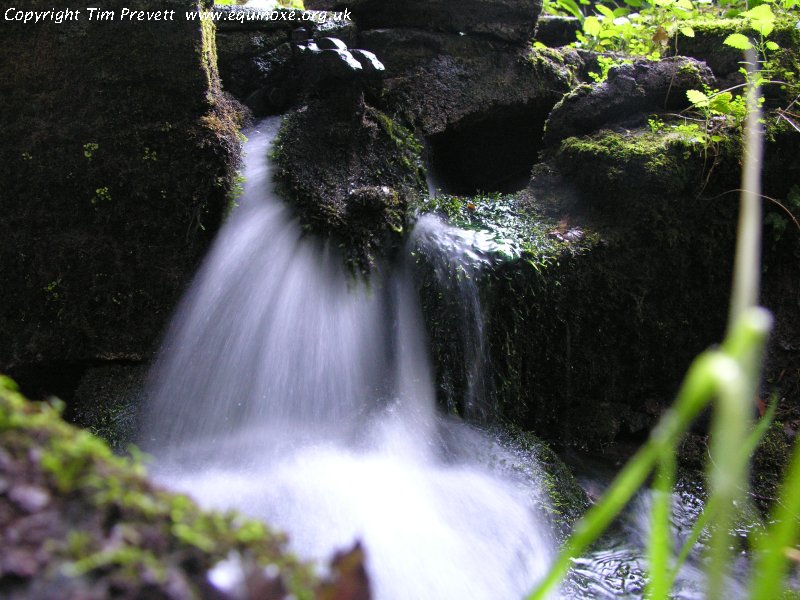
St Milburga's Well (Stoke St Milborough) submitted by TimPrevett on 23rd Sep 2007. The superlative St Milburga's Well at Stoke St Milborough. One of the best I have visited. It is situated in its own enclosure to the immediate adjacent west of the road which arcs to the east of the village.
The flow is the strongest I have observed on any holy well, coming through a pipe at the bottom of a flight of steps. A standpipe stands outside the enclosure, and with a turn of the knob, yields water.
Pay attention to the latch on the gate and head on the handrail, too.
(View photo, vote or add a comment)
Log Text: St Milburga's Well, Stoke St Milborough: We visited the church first of all, and whilst some of the church dates from the 13th century, there was little of this in evidence, the fabric having been restored in Victorian times. The church had been left open, so we looked inside, but not much of note, apart from the lovely geese (I thought they were ducks until I saw the official records) carved into the top of the wooden door into the base of the tower at the west end.
Not having a map for this area, we thought the holy well might be near to the church, but thankfully bumped into the church warden as we exited the church. He was carrying a large wooden stake and hammer, so I joked with him "are you hunting vampires?". It turned out he was marking out a burial plot for a recently deceased villager.
He directed us to the well, but told us that "thanks to the water company, there's very little left of the well". Coming out of the churchyard, we headed south on the minor road, then turned left and headed up the hill, following the road round to the left as it levelled off. Just round this bend, there was a gate into the well enclosure. Steps led down to the well head, which still exists, together with a small well pool and a lively outflow into a stream which heads westwards, back towards the church.
A very peaceful spot. Just a shame about the modern domestic water apparatus next to the well.
St Julian's Well (Ludlow)
Date Added: 9th Aug 2021
Site Type: Holy Well or Sacred Spring
Country: England (Shropshire)
Visited: Yes on 15th Jul 2021. My rating: Condition 3 Access 5
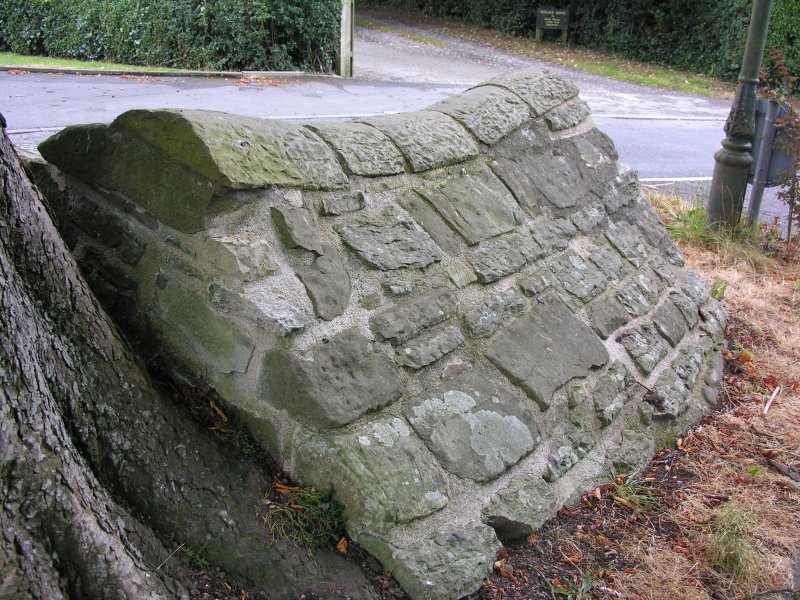
St Julian's Well (Ludlow) submitted by TimPrevett on 23rd Sep 2007. The obvious or not so obvious if you don't know it's there - St Julian's Well in the centre of Livesey and St Julian's Ave, Ludlow. A property called Wellside is to its north. This was the first not famous holy well I went in search of several years ago, and I'm glad to have worked out where it is at last!
(View photo, vote or add a comment)
Log Text: St Julian's Well, Ludlow: Last stop of the day before collecting our car from the garage and driving back to the holiday cottage, then home tomorrow. The well was deep in dappled shade, it being late afternoon on a hot, sunny day. We parked just south west of the well, at the side of Livesey Road. This road was busy with other cars, presumably because of all the roadworks in the area, routing cars along past the well.
A very odd spot for the well, and the tree next to it had grown over part of the well structure. Someone had wedged a drinks cannister into what had been the pipe from inside the well house, which now appeared to be dry. We couldn't see any obvious channels for water to flow down, and we were unable to hear any water flowing anywhere in the vicinity.
Worth stopping off to take a few photographs, and another well site to tick off the list.
St Andrew's Well (Wells)
Trip No.136 Entry No.3 Date Added: 12th Jun 2019
Site Type: Holy Well or Sacred Spring
Country: England (Somerset)
Visited: Saw from a distance on 17th May 2019. My rating: Condition 4 Ambience 4 Access 4
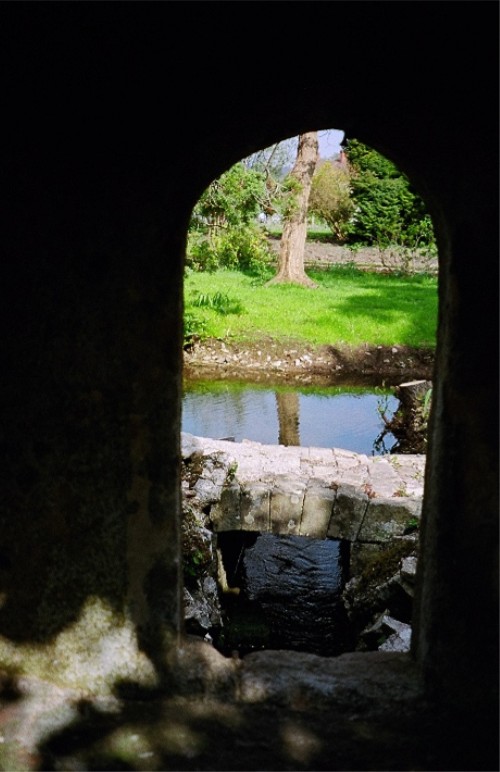
St Andrew's Well (Wells) submitted by KiwiBetsy on 21st Nov 2004. A peep hole gives a view of St Andrew's Well.
(View photo, vote or add a comment)
Log Text: St Andrew's Well, Wells Cathedral: After having had an abortive trip trying to find the sculptured Anglo Saxon stones (now shut up in boxes and cages on the triforium, only accessible by cathedral staff) I only photographed this through the hole in the garden wall separating the cathedral from the Bishop’s Palace. We didn’t have time to go to the Palace as we needed to beat the traffic and get to Deerhurst or Bradford on Avon before the churches shut for the evening.
Wells Cathedral
Trip No.136 Entry No.2 Date Added: 12th Jun 2019
Site Type: Early Christian Sculptured Stone
Country: England (Somerset)
Visited: Yes on 17th May 2019. My rating: Condition 4 Ambience 4 Access 4
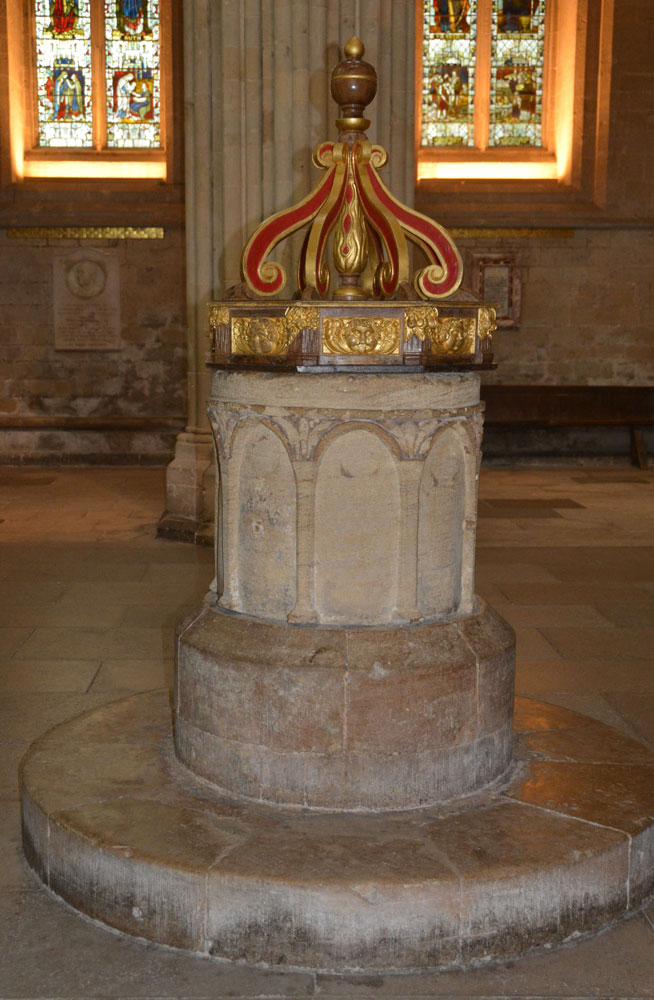
Wells Cathedral submitted by Anne T on 11th Jun 2019. The font in the south transept of Wells Cathedral, recorded as AS Corpus Wells 04, said to be from the original stone cathedral, dated to the 10th to 11th century and recorded as being in situ at this location since the 12th century. The font bowl is cylindrical and tubshaped, and is cut from a single block of Chalfield Oolit limestone. Over the centuries it has been partly recut and remodelled.
(View photo, vote or add a comment)
Log Text: AS Corpus Wells 4, Wells Cathedral: We'd been seriously held up by traffic on the major and minor roads from Exeter to Wells, then by seriously slow roadworks, so were really rushed for time. I'd previously contacted the cathedral to find out if it was possible to see AS Corpus Wells 3, which the Corpus said was in the cathedral store, but the cathedral said they were unable (unwilling) to find it. Thinking the other fragments would be on display, we still went to the Cathedral. Throwing the car into a car park just inside the city centre, I managed to photograph the Market Cross/Bishop Beckington's Conduit before going to the Cathedral.
I showed one of the guides the AS Corpus notes and asked if he knew where they might be on display and were told ‘try the undercroft’. Nothing of note in there – it was very bare with very little displayed.
After wandering up and down the nave and chancel, I stopped another guide, showed her my notes, explained I’d previously emailed. She told me one of the stones was in the library, but a special tour had just started and it would be at least an hour before we could get in, and to look at the fragments built into the walls of the cloisters. She then said she’d find one of the vergers and ask him if he knew where the others were.
Eventually, this very kind lady came to find us and took us to the verger’s office, where he looked at my papers. “Oh, yes”, he said, “I remember the email. Everything is now in storage in the triforium, either in boxes or cages, and can’t be accessed.” “That’s disappointing”, I replied, “why did no one tell me that in the email reply?” We were dismissed without a further word, with the verger turning back to another visitor to his office.
We went to find a late lunch in the cathedral cafeteria, only to find it almost empty and only serving coffee and cakes. We left, rapidly, with only a few postcards as souvenirs, and feeling the cathedral had been stripped bare of its medieval treasures and soul.
Not a very satisfactory visit, possibly spoiled by the huge rush we'd been in, the lack of finding the recorded stones on display and being badgered on several occasions to make donations.
Great North Museum (Anglo Saxon Stones)
Trip No.72 Entry No.2 Date Added: 13th May 2018
Site Type: Museum
Country: England (Tyne and Wear)
Visited: Yes on 4th May 2018. My rating: Condition 3 Ambience 4 Access 5

Great North Museum (Anglo Saxon Stones) submitted by Anne T on 11th May 2018. This is the front of the Rothbury Cross head, described as one of the finest pieces of Anglo-Saxon sculpture from the Kingdom of Northumbria. It is carved with scenes of the crucifixion and other motifs. The museum sign says it was made about 100 years after the Lindisfarne Gospels but "clearly belongs to the same artistic tradition." From the collection of the Society of Antiquities of Newcastle upon Tyne. Submitted with the kind permission of the Great North Museum.
(View photo, vote or add a comment)
Log Text: Great North Museum, Anglo Saxon Exhibit: A small but nicely presented collection of Anglo Saxon cross fragments and grave goods. Ground floor. See general SID page for Great North Museum for main visit report.
Great North Museum (Rock Art)
Trip No.72 Entry No.3 Date Added: 13th May 2018
Site Type: Museum
Country: England (Tyne and Wear)
Visited: Yes on 4th May 2018. My rating: Condition 3 Ambience 4 Access 5
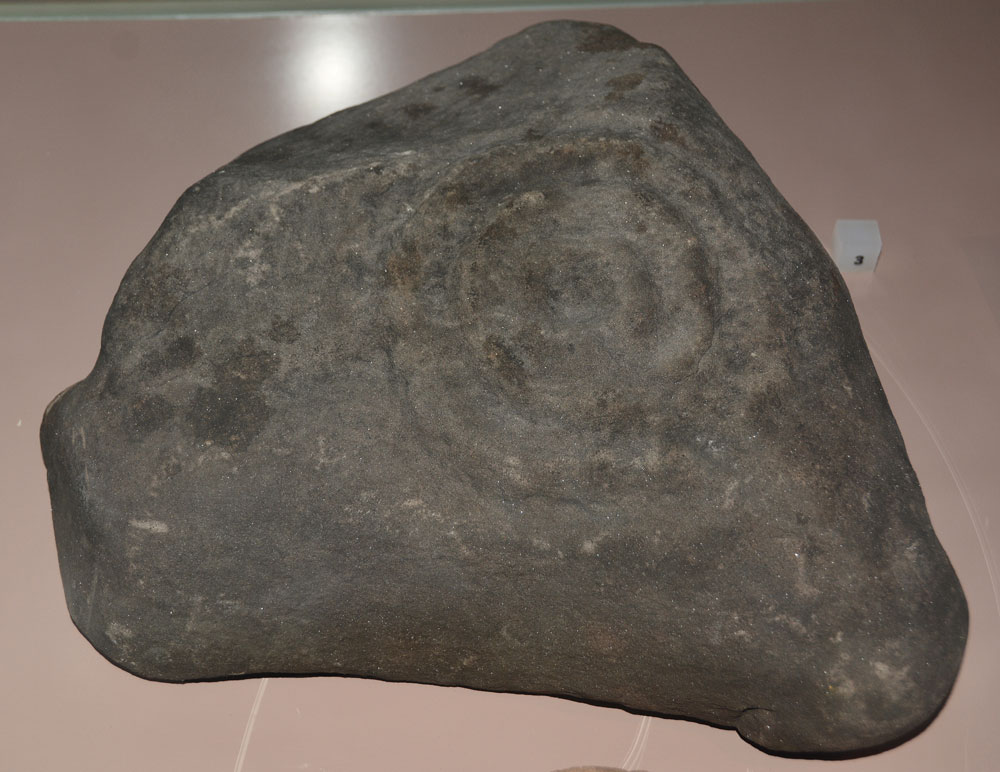
Great North Museum (Rock Art) submitted by Anne T on 10th May 2018. On display in a case in the Prehistoric display on the ground floor. Comparing photographs, I think this is Fowberry Moor Farm, Island/Deershed Plantation Panel, ERA-1842, Beckensall 179. The panel is stained dark red due to peat staining.
Submitted with the kind permission of the Great North Museum.
(View photo, vote or add a comment)
Log Text: Great North Museum (Rock Art): in the 'Prehistoric' Exhibition on the ground floor (see the general Great North Museum page for full visit report). A real shame that most of the exhibits were behind glass, and very close together, which made them difficult to photograph. It was nice to see some of the Beckensall RA stones which had been donated to the museum - but I wonder where the rest are, and there are quite a few. These seemed relatively poor examples given the photos I've seen on the ERA website. Much enjoyed seeing these.
The Ponteland Boulder
Date Added: 24th May 2015
Site Type: Rock Art
Country: England (Tyne and Wear)
Visited: Yes on 17th May 2015. My rating: Condition 3 Ambience 3 Access 5

The Ponteland Boulder submitted by Anne T on 18th May 2015. This recently discovered boulder sits in the gardens of the Great North Museum, to the right hand side of the access road which leads to the bank of bins at the rear door of the museum.
(View photo, vote or add a comment)
Log Text: The Ponteland Boulder, The Great North Museum, Newcastle-upon-Tyne: We'd been told about this boulder in March by one of guys at the Archaeological Group who is a very keen tracker of any new rock art found in the region. Then, strangely, it came up in Rock Articles which was emailled to me by Dr. Kate Sharpe at the University of Durham. Having been asked to look after our very young granddaughter for the day, plans for a long day out walking were truncated so we decided to head off into Newcastle and go searching for this boulder.
Walking through the University of Newcastle campus, we crossed Claremont Road and walked almost right round the museum and back again without spotting this stone. I was just about to head off into the museum to ask when my husband dived off into a small garden area fronting onto the main road, towards the bins. He came rushing back to tell me he'd found it.
Sited almost opposite the bank of big blue wheelie bins on the access road to the rear/delivery entrance to the museum wasn't maybe the best spot for this boulder, but here it was never-the-less.
There is obvious plough damage to the edges of the stone and it has been quarried at some point, making it originally much larger than it currently is.
The cup and ring motifs, particularly those at the edges of the boulder, had peck marks (like at Fowberry Park) next to them.
Definitely worth a visit if passing by. Note to those of you with families: at the far side of the museum, next to the car park, there is a large stone rhinoceros which is interesting to be photographed next to (but definitely not megalithic!).
Jarrow
Date Added: 22nd Jun 2015
Site Type: Ancient Cross
Country: England (Tyne and Wear)
Visited: Yes on 10th Jun 2015. My rating: Condition 3 Ambience 4 Access 5
Jarrow submitted by Thorgrim on 25th Oct 2004. Cross fragments
(View photo, vote or add a comment)
Log Text: Anglo Saxon Fragments, St Paul's Church and St Bede's Monastery, Jarrow: We parked at Bede’s World (a couple of hundred yards away from the church and the monastery) and having decided to start off at St Paul’s Church, we followed (or tried to follow) the signs, which took us across the busy main road to another car park. All the paths seemed to lead into the middle of no-where. After 10 minutes wandering around in circles with granddaughter in pushchair, I finally went inside to ask. The girls at the Bede’s World reception had to go and ask. “It’s straight through the park”, they told me. All the posters up in the reception area said the church was open until 15:30 so we thought we had plenty of time.
Not being able to get the pushchair down the ramp into the park (too overgrown) we followed the pavement along the main road down to the church, where we had to manoeuvre round tree cutters to follow the path up to the west porch. We were greeted by the ruins of St Bede’s Monastery on our right hand side – such an ancient building incongruously topped by modern pylons rising up behind.
It turned out the church was only open until 3pm so we only had 10 minutes to go in, wander round, take photographs and try and appreciate the history of what we were seeing. A volunteer came up to us and I waved the Corpus of Anglo Saxon stone sculpture pages that I’d printed off and explained I was on a ‘treasure hunt for Anglo Saxon cross pieces’. Instead, we got drawn into the old monastery chapel for a guided tour. The rest of the church seems, and feels, pretty ordinary, but this old chapel, dating from AD681 with its dedication plaque above the entry arch, was very moody and special. The lady pointed out the two pieces of original Anglo-Saxon glass in the south windows.
It also turns out that the fragments are now in display cases, rather than being displayed in the porches, which made them incredibly difficult to photograph, as the light coming through the church windows reflected in the glass, as did the flash when I tried to use it. By this point, they were turning the lights off in the church to go home, although they very kindly let us stay an extra 10 minutes so I could photograph some of the artefacts. Definitely a second trip needed when there’s more time to wander round the old church and the ruins of the monastery outside.
St Nicholas's Cathedral (Newcastle)
Date Added: 21st Oct 2019
Site Type: Ancient Cross
Country: England (Tyne and Wear)
Visited: Yes on 6th Oct 2019. My rating: Condition 3 Ambience 4 Access 4
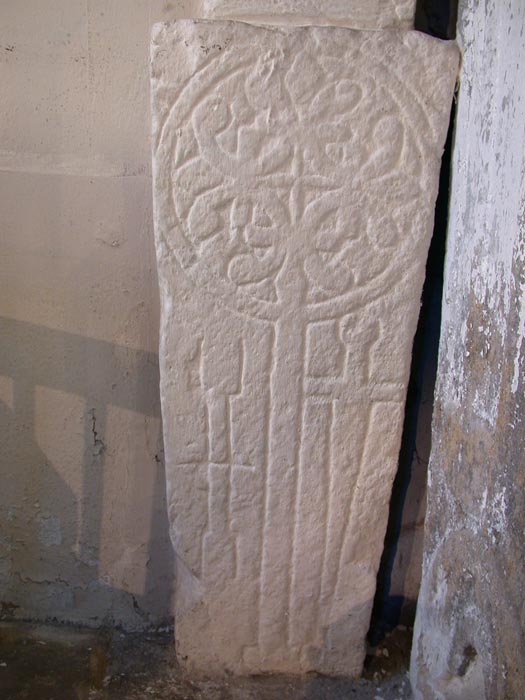
St Nicholas's Cathedral (Newcastle) submitted by nicoladidsbury on 13th Aug 2005. Elaborate Cross Slab, featuring two vertical sword shafts, similar to much smaller cross slabs found built into the fabric of the Norman wall in the ancient church at Old Ireby
(View photo, vote or add a comment)
Log Text: St Nicholas's Cathedral, Newcastle: We went to photograph the four cross slabs recorded by Ryder in St Margaret's Chapel, plus two others - one in the western of the three tomb recesses in the south wall of the south aisle; the other in the south wall of the south transept, at its eastern end.
I've since arranged to return on 16th October to photograph the slabs now stored in the vault under the south transept, although access is through a trapdoor and down a ladder!
Exhibition Park Circle
Trip No.18 Entry No.5 Date Added: 24th Apr 2017
Site Type: Modern Stone Circle etc
Country: England (Tyne and Wear)
Visited: Yes on 23rd Apr 2017. My rating: Condition 4 Ambience 1 Access 4

Exhibition Park Circle submitted by Anne T on 24th Apr 2017. Standing at the bandstand side of the mound, looking northwards at the five stones.
(View photo, vote or add a comment)
Log Text: As we’d failed to find the Axwell Park Tumulus, we sat in Café Nero in Fenwicks and I was looked up details of sites we were going to on the mobile version of the Portal. I came across an entry for ‘Leazes Park Circle’ which mentioned a modern stone circle. This took me by surprise, as we’ve been parking our car by Leazes Park when we come into Newcastle, at least once a week, and not come across any mention of this before. Bringing the map up on my phone, we sat puzzling where this was, and decided to head off and look for it.
'Modern Stone Circle', Newcastle: In actual fact, it is in Exhibition Park, not Leazes Park, although I’ve spent a while trying to find more about this on the web. Not finding anything, I’ve emailed the Parks and Countryside Department at Newcastle City Council, simply out of curiosity.
Having stumbled upon the ‘circle’ (the grid reference on the Portal was also a bit off), I’m convinced it’s part of the children’s play park. However, I might yet be proved wrong. When we arrived, a student was walking over the tree trunk to the mound and generally walking around the ditch surrounding this tiny ‘monument’. Disappointing, but pleased to have found it and been able to contribute a photograph to the Portal.
Ryton Motte or Tumulus
Trip No.18 Entry No.1 Date Added: 24th Apr 2017
Site Type: Artificial Mound
Country: England (Tyne and Wear)
Visited: Yes on 23rd Apr 2017. My rating: Condition 3 Ambience 4 Access 4

Ryton Motte or Tumulus submitted by Anne T on 24th Apr 2017. The motte seen from its eastern side. Graves had been cut into most sides of the bottom of the motte.
(View photo, vote or add a comment)
Log Text: Ryton Motte, Gateshead: Parking on the main road opposite The Old Cross pub and Holy Cross church on Barnmoor Lane, as there was an event on at the church, the first surprise was to see the old cross located on the village green.
Pastscape reveals this is relatively modern, having been erected in 1765, but the base looks much, much older. Historic England say in list entry 1018642 that there was evidence of an earlier cross on this site.
A stream of very well dressed people were exiting the church yard, indicating a service had just finished. I spent a few minutes photographing the cross, then we sauntered in the churchyard. The name board on the gate to the churchyard says that the church was founded in 1220, and whilst there appears to be old stones in the fabric of the church, popping our head into the church itself, it looks very Victorian. There were people inside, so we didn’t linger.
Walking round the tower at the west end of the church, and round to the north wall, we came across a man digging up brambles and dock plants around the graves. He told us he wasn’t’ associated with the church, but had got fed up of the graveyard looking as it did. He also said he’d just removed shrubbery and brambles off the motte, which looked bare and brown in the warm sunlight. He also told us to look out for the grave of a woman to the north-west of the motte, which had inscribed on the headstone about the grave also containing her husband, who’d lost his arm at Trafalgar.
The motte is certainly a significant structure (I thought it was only small, but it’s not, measuring 3.30 metres with a diameter of 30 metres, according to Pastscape. The mound certainly appears much higher when viewed from the river side, where it looms high above you.
These days, the river is largely hidden by trees, but glimpses of silver water appear as you follow the path round the motte and back up to the east side of the church. It would have had a very commanding spot above the river when it was built.
Holy Well, Greenside
Trip No.18 Entry No.2 Date Added: 24th Apr 2017
Site Type: Holy Well or Sacred Spring
Country: England (Tyne and Wear)
Visited: Yes on 23rd Apr 2017. My rating: Condition 4 Ambience 4 Access 5
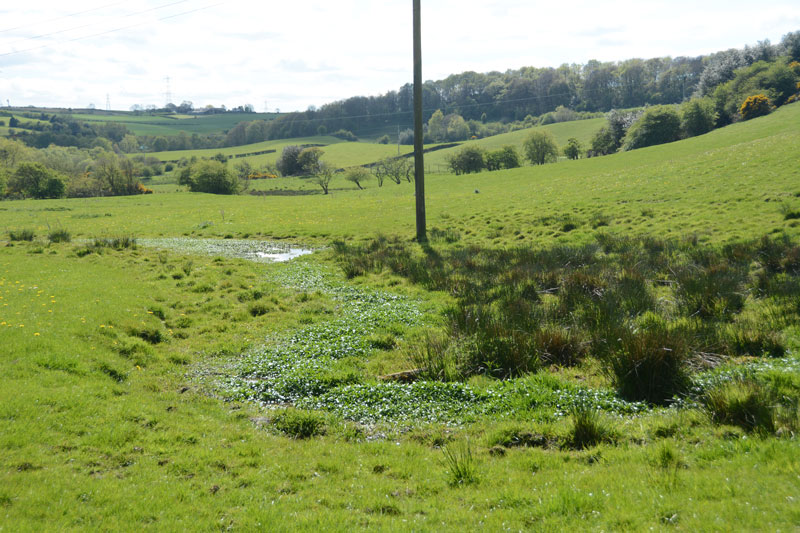
Holy Well, Greenside submitted by Anne T on 24th Apr 2017. Holy Well, Greenside from the gate in the field on Barlow Lane.
(View photo, vote or add a comment)
Log Text: Holy Well, Greenside: From Ryton Motte, we headed off south towards Greenside through the back lanes. Considering how close were are to Winlanton, Blaydon, Gateshead and Newcastle, you could be forgiven for thinking you were in the depths of the countryside at this site. Disappearing down a small road leading from Greenside to Barlow (Barlow Lane on UK Grid Finder) we parked where the lane met a tarmacked path leading to Reeley Mires Farm. It was then a question of walking a couple of hundred yards south-east down Barlow Lane, where the well is located at the base of the Drumlin.
To your right hand side, as you walk down the lane, there is a red metal gate into the field, although this is heavily overgrown by hawthorn and brambles, and is impossible to open. The central pool of the well can be seen at near the base of a telegraph pole, although the whole feature forms an attractive long ‘s-shape’ in the pasture.
It is a really pretty spot here. I was impressed there was so much water here, as it has been little rain here for weeks.
Have as yet been unable to find any notes/further information about this well. Thanks to durhamnature for his original entry.
